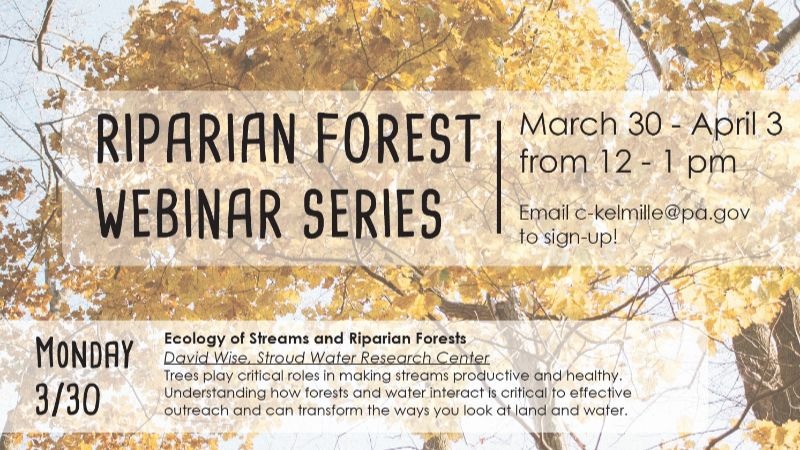Riparian Forest Webinar Series

- This event has passed.
Riparian Forest Webinar Series
March 30, 2020 – April 3, 2020 EDT

When: March 30 – April 3 from 12 to 1 p.m. each day.
Where: Online via Skype.
Monday, March 30, 12 – 1 p.m.
Ecology of Streams and Riparian Forests
David Wise, Stroud Water Research Center
Trees play critical roles in making streams productive and healthy. Did you know? Trees provide the majority of energy for stream life. Most of that energy comes as dissolved organic compounds we call watershed tea. Forested streams are 2-4x wider than grass buffered streams (2-4x more room for life). Forested streams have 3-5x more life than grass buffered streams. Some stream insects must feed on hardwood tree blossoms before they can reproduce, while others require logs that span the creek to lay eggs above the creek, safe from egg predators in the stream. Our streams provide critical environmental services such as removing nutrients and toxins and do their best work when aided by trees. Forested buffers not only act as filters/barriers that reduce pollutant loading to streams. Streamside trees transform streams so that the stream itself is enabled to deal with the pollutants that reach the channel. Understanding how streams work and the importance of trees to streams is fundamental to engaging landowners and decision makers. Many past participants have found this information transformative and expanded their understanding of how streams work.
Tuesday, March 31, 12 – 1 p.m.
Do Hellbenders, Freshwater Mussels, and Native Brook Trout Matter?
Eric Chapman, Western Pennsylvania Conservancy
Riparian buffers are one of the most important restoration project types for increasing clean water potential in Pennsylvania and beyond. The significance of this best management practice is well understood but the types of aquatic species that could benefit from their installation is often much less considered when a riparian buffer is installed. WPC staff have been installing riparian buffers in earnest since 2010 and often try to install these practices in watersheds that have several if not all of the important aquatic species (hellbenders, mussels, and brook trout) to WPC scientists and funders alike. These species inhabit different parts of the watershed, headwater areas contain brook trout and the middle and lower portions of the watershed typically contain hellbender and mussel populations. A top down approach to riparian buffer planning can yield the highest return on a conservation investment due to clean “filtered” water high in the watershed which will eventually make its way down to the hellbenders and mussels present lower in focal watersheds.
Wednesday, April 1, 12 – 1 p.m.
Selling Buffers WITHOUT Financial Incentives
Ryan Davis, Alliance for the Chesapeake Bay
For decades, the prevailing thought has been that landowners will only agree to riparian reforestation if there are substantial financial benefits attached, namely through CREP. The advent of flexible non-federal funding for buffers has shown that remarkable progress can be made toward PA’s buffer goals without the promise of rental payments. Join Ryan Davis, a biologist who has years of experience with both CREP and non-federal buffer implementation, to hear tips, tricks, and insight on selling riparian forest buffers without financial incentives and federal programs.
Thursday, April 2, 12 – 1 p.m.
Reforesting Shallowbrook School
Jodi Sulpizio, Penn State Extension
Beginning in autumn 2019, a huge reforestation project broke ground on Northeastern School District property in York County. When completed, the project will total nearly 20 acres of riparian forest buffer and upland lawn conversion. The project alone will complete 1/4 of York County’s goal for urban riparian forest buffers and is already accelerating buffer implementation in the county. The project began as the dream of a science teacher in the school district, who through his participation in the Penn State Master Watershed Steward program was introduced to partners at the PA Department of Conservation and Natural Resources and the Alliance for the Chesapeake Bay. Together, the group was able to get school board permission and secure funding for the massive project. Scores of volunteers from Master Watershed Stewards and the community are fastidiously maintaining the site and using the project as an advertisement for riparian forest buffers in the region. The reforestation of Northeastern School District serves as a case study in the power of partnership and grassroots engagement, and the project can be replicated across the Commonwealth to help meet our buffer goals.
Friday, April 3, 12 – 1 p.m.
Pre- and Post-Planting Vegetation Management for Establishment
Art Gover, Penn State University
It verges on axiomatic that candidate sites for establishing riparian forest buffers are currently hosting a plant community that is not a recognizable successional stage of native. Common sites range from current pasture or crop land to abandoned crop or marginal land populated by mixtures of exotic trees, shrubs, vines, and persistent herbaceous groundcovers. Successful conversion to forest requires reducing competition from the existing vegetation to provide added trees a free-to-grow condition, creating a belowground soil microbial community compatible with reintroduced native woody species, and preventing re-establishment of an exotic plant community. Operationally, this means planting trees is the middle phase, not the beginning. Aphoristically, the process is a) find the site, b) determine what’s there and how long it takes to remove it, c) actually remove it, d) introduce your new plant community, and e) actively encourage optimal growth of your desired community at the expense of undesirable plants.
Details
- Start:
- March 30, 2020
- End:
- April 3, 2020
- Event Category:
- Webinar
- Event Tags:
- Watershed Restoration
